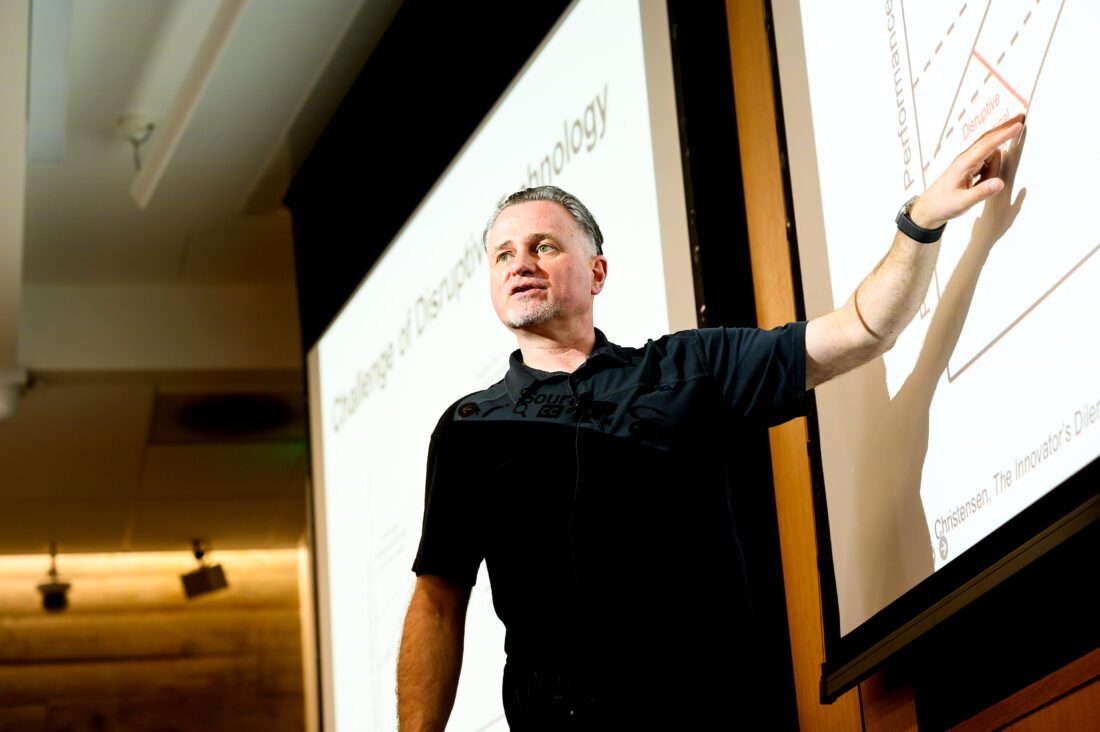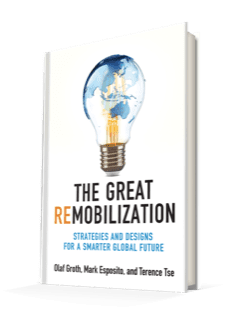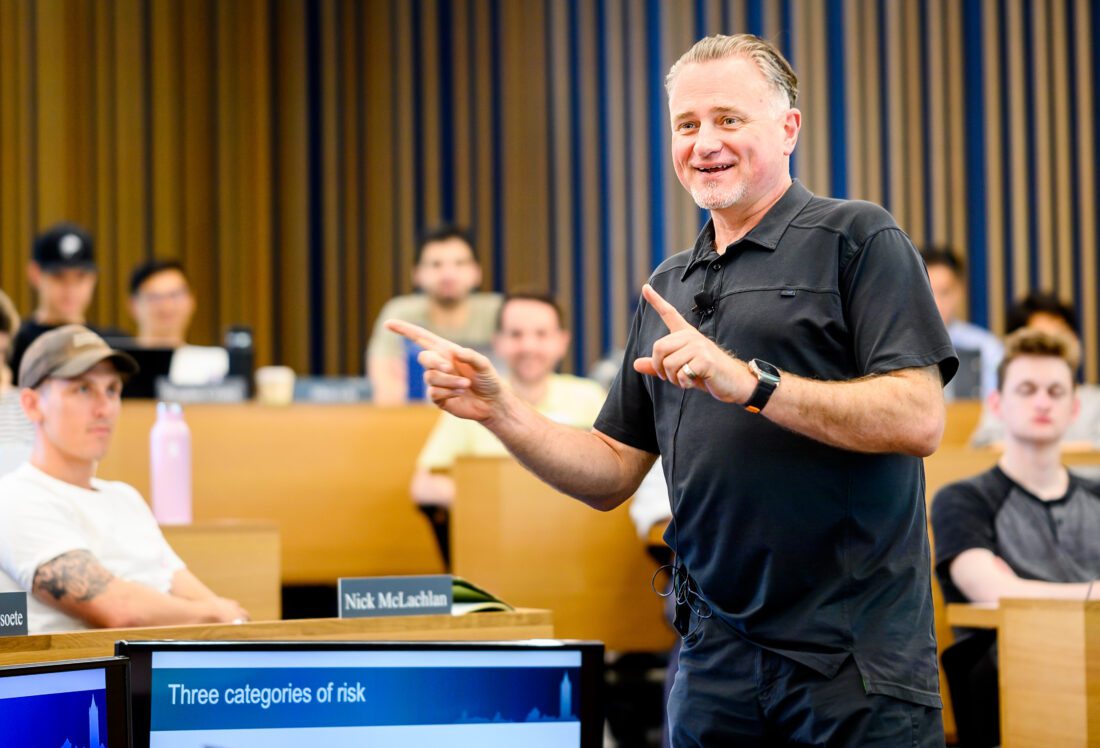
Olaf Groth doesn’t like to make predictions, but he’s nonetheless become adept at helping executives see around corners and navigate the chaos of recent years.
A member of the Berkeley Haas professional faculty, a senior adviser at the school’s Institute for Business Innovation, and the faculty director for the Future of Tech program at Berkeley Executive Education, Groth is also chairman and CEO of thinktank Cambrian Futures.
 In a new book, The Great Remobilization: Strategies and Designs for a Smarter World (MIT Press), Groth and coauthors Mark Esposito and Terence Tse (and editor Dan Zehr) focus on what they call the Five Cs—COVID; the cognitive economy, crypto and web 3; cybersecurity; climate change; and China. They show leaders how to power human and economic growth by replacing fragile global systems with smarter, more resilient ones.
In a new book, The Great Remobilization: Strategies and Designs for a Smarter World (MIT Press), Groth and coauthors Mark Esposito and Terence Tse (and editor Dan Zehr) focus on what they call the Five Cs—COVID; the cognitive economy, crypto and web 3; cybersecurity; climate change; and China. They show leaders how to power human and economic growth by replacing fragile global systems with smarter, more resilient ones.
In one chapter, the authors imagine a harrowing scenario they call “the Great Global Meltdown of 2028,” the economy collapses after a hack of a critical global payments system in the midst of recurring climate and COVID crises; nearly 1 billion people suffer mental health issues from the strain.
But with the help of the ideas in the book and a bit of practice, leaders can learn to “flip the chaos forward into opportunity,” the authors argue. The book, shortlisted for the Thinkers50 Strategy Award, launches on Oct. 17.
We talked with Groth about how executives can learn to turn turmoil into opportunity.
Your book talks about the need for humanity to make the leap from the “raging 2020s” to a “great remobilization” in the late 2020s and beyond. What will need to happen?
We’re looking at utter volatility over the next 10 years. We can’t afford to sit on the couch and just watch. We have an opportunity now to redesign how business leaders generate growth—both for their shareholders as well as for a broader set of stakeholders—that takes into account how the global economy has changed and continues to change. The book is all about: Where do we go from here? Are we going to accept that we’re going to have a fragmented world where people don’t trust each other, where trade and investment are inhibited, and where growth is limited?
“We can’t afford to sit on the couch and just watch. We have an opportunity now to redesign how business leaders generate growth—both for their shareholders as well as for a broader set of stakeholders—that takes into account how the global economy has changed and continues to change.”
What will the next era of globalization look like amid an era of rising economic nationalism, fragile supply chains, and recurring pandemics and natural disasters?
The globalization everyone keeps talking about is how many bananas get shipped from Argentina to China with the greatest degree of efficiency. And of course that’s important for jobs today. But what we really have to ask is, who controls the flow of any given thing from one place to another? At the end of the day, the people who have the power in what we call the “cognitive economy” can influence these flows. There are traditional flows—of capital, of intellectual property, of people, of goods and services. But there are also new flows of behavioral data, genetic material, and crypto currency. And that’s not even including the ecological flows of energy, air, water, and pathogens.
You define the cognitive economy as a world of algorithms automating or augmenting human decisions and tasks and spinning out valuable insights that can be used to improve businesses, governments, and society. What’s at stake for managers and leaders in a cognitive economic future?
In the cognitive economy, cybernetics functions are getting injected into everything we do—essentially intelligent, digital, command-and-control functions that are at the moment centrally steered by the likes of Google, Amazon, Baidu, and Alibaba. We need to see the new principles bubbling up now from the cognitive economy. Leaders need to be able to perceive the new operating logic in their domain and in their industry.
Take supply chains: 46% of supply chain managers are saying that investments in AI and automating human decisions is their top priority. That means we’ll see new types of integration of human and machine predictions and decisions. Or take the mobility industry. Electrified, autonomous cars use AI to create applications inside the car, and cars are now starting to be tied to a new charging infrastructure around the smart home. You need to design cars like they’re an iPhone: you start with a chip and you build everything around that. Essentially, the automotive industry is being scrambled, as is the energy industry, the home appliances industry, etc. Who controls these complex systems? How do you see those new patterns if you’re an executive any given industry?

Your book describes a FLP-IT (forces, logic, phenomena, impact, and triage) model for strategic leadership. How should executives approach the triage step, which requires them to make tough decisions about what to keep, discard, or build from scratch?
I was at the World Economic Forum meeting in Tianjin and a senior executive in the petrochemicals industry told me that after 30 years of building megafactories in China, his company now needed to throw that out the window and create chains of “nanofactories” across 12 different markets to create resiliency. To solve that kind of challenge you need to understand what to invest in and what to divest of. Because strategy is just as much about what you do as it is about what you no longer do.
Most executives are bad at dropping things that they hold dear. They need to make conscious choices.
“Most executives are bad at dropping things that they hold dear. They need to make conscious choices.”
Once you understand the new operating logic in your industry or domain, you need to redraw its boundaries and diagnose changed power relations. To address those changes, you have to then free up resources from activities that are not aligned with the new arena to create new ones that are. For instance, if you are a food conglomerate with most of its agricultural activities in the global south, how will you need to reconfigure that for massive labor migration coming in the face of climate change? Do you have the cognitive technologies, including AI, data science and automation in place to make your supply chains more intelligent, agile and resilient?
You argue that China is an indispensable partner for any global systems redesign. How will leaders in the rest of the world need to reimagine their engagement with a rapidly aging and slowing China while navigating rising economic and military tensions?
Not every investment in China is bad and we’re not advocating for a wholesale withdrawal from all activities in China. That total decoupling is not desirable for anybody. In fact, there are lots of new opportunities for joint solutions that serve both our economic and national security interests as Americans and Chinese. Let’s talk about the fact that China’s coastal cities are as screwed as America’s cities are with sea levels rising. Hundreds of millions of people will be migrating north. That could mean joint investment in climate change mitigation and adaptation solutions, in new approaches to education, in regulating and managing migration, in innovation for public health and early pandemic detection and warning systems.
At some level, we’re going to get down to technologies that are sensitive, like chips and AI. And granted, you can weaponize almost anything these days. But there are technical ways to govern that, design protocols for dispute resolution and risk mitigation. We can watermark and forensically trace content, technical components and code. We can figure out where specialized microchips are going. We can put protocols in place to jointly identify and settle infractions and misunderstandings. It’s not perfect, to be sure. Nothing ever is. But we have to try, because the alternatives are even worse.
So there’s some optimism in your message?
I have a conviction that a lot of these problems are truly solvable with the right design. Executives need to get out there and try things with risk-bounded experiments. This is a craft you can learn. We give leaders a roadmap to lead people into a new future that’s better than one of distrust, fear, and fragmentation.